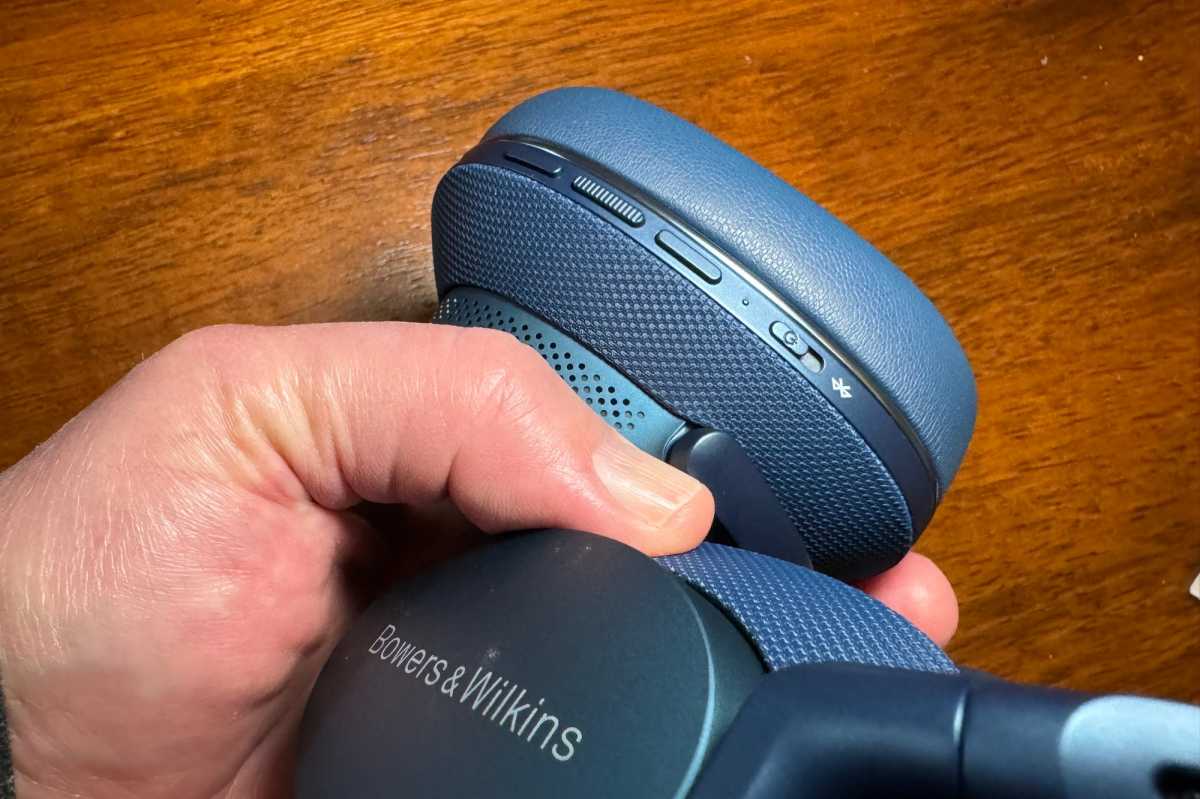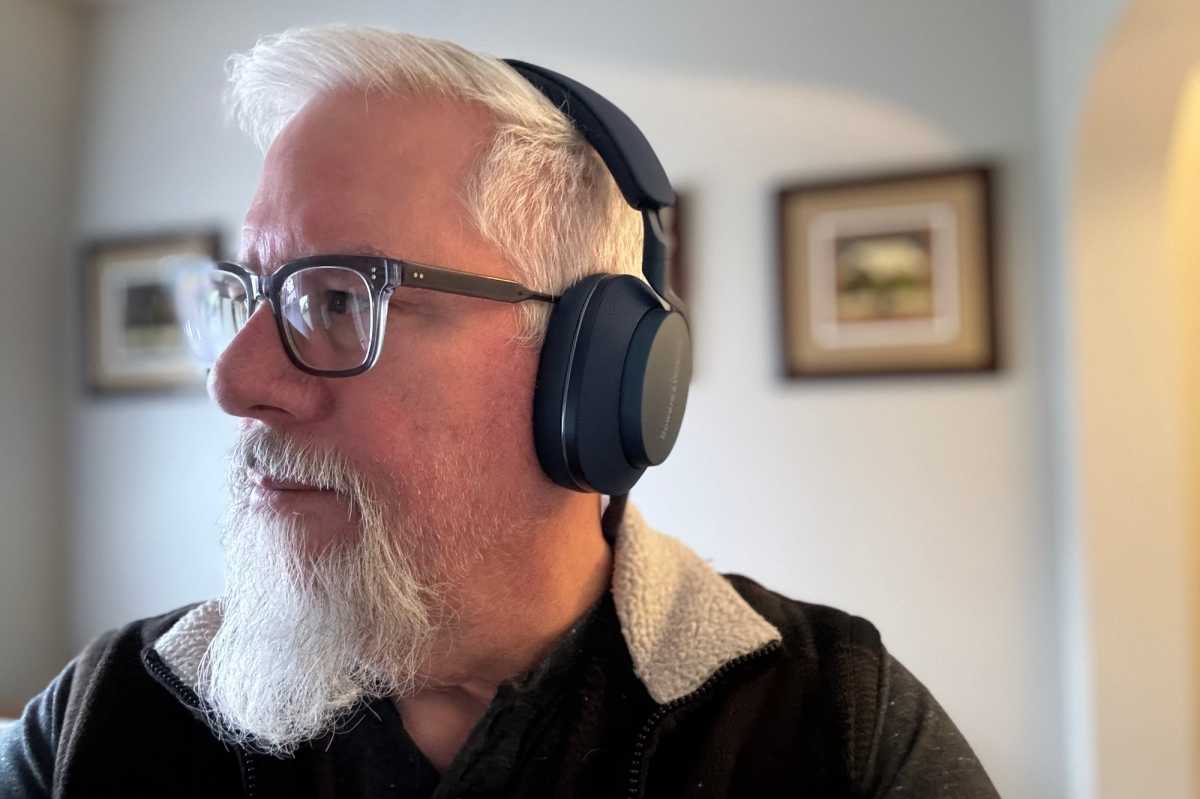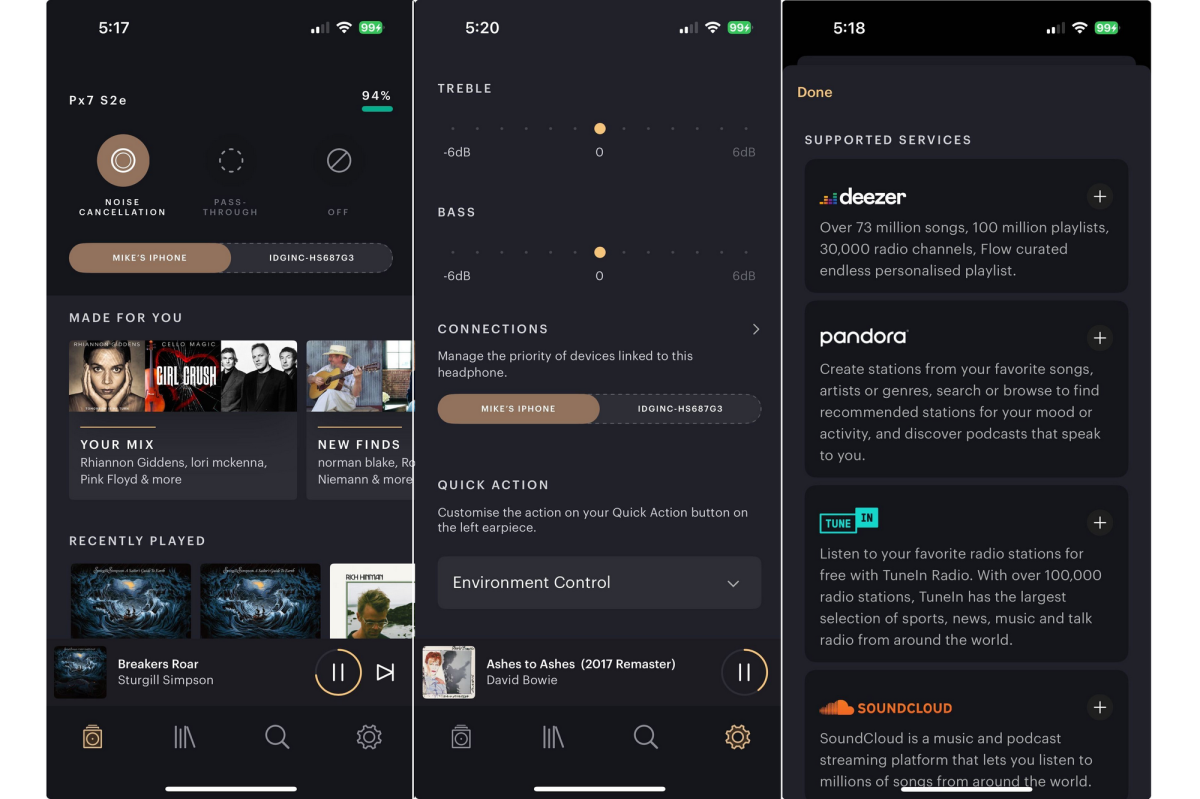At a glance
Expert’s Rating
Pros
- Excellent audio fidelity
- Very good active noise cancellation
- Beautiful design, fabulous build quality
- USB audio interface for wired connection to smartphones
Cons
- Not as flashy as the competition from Bose and Sony
- ANC prowess still lags Bose and Sony
- Still no support for surround sound formats like Dolby Atmos
Our Verdict
Billed as an “evolution” over the fabulous Px7 S2 that hit the market just last year, Bowers & Wilkins’ Px7 S2e is a subtly better headphone everywhere that counts.
Price When Reviewed
$399
Best Prices Today: Bowers & Wilkins Px7 S2e
$349.40
Bowers & Wilkins describes its all-new Px7 S2e headphone as an “evolved” form of the Px7 S2 I heaped praise on in my June 2022 review. Indeed, any changes in industrial design are quite subtle. The evolution comes in the form of a new digital signal processing engine that gave B&W’s audio engineers an opportunity to retune the 40mm drivers in this new headphone.
Oh, the Px7 S2e are also available in a new color, Forest Green. The review sample B&W sent for this review is the very pretty Ocean Blue. Both shades are a nice departure from the black headphones I typically get in for review, but you’re not considering $399 headphones based on their color scheme.
I described the previous model as possessing more steak and less sizzle, and that’s what B&W delivers here as well. The Px7 S2e aren’t festooned with the fancy features you’ll find on the best headphones from Sony or Bose, nor do they deliver the state-of-the-art noise cancellation those brands justifiably boast of. What the Px7 S2e do deliver is slightly more faithful audio reproduction than their predecessor.
If noise cancelling takes a back seat to audio fidelity in your book, it’s the Bowers & Wilkins Px7 S2e you’ll want to strap to your head.
Design and build quality

You’ll be hard-pressed to tell the difference between the Px7 S2e and the Px7 S2 they replace; at least, until you listen to them.
Michael Brown / Foundry
The Px7 S2e’s industrial design, like the model it succeeds, hews closely to that of B&W’s considerably more upscale Px8. The buttons and their locations and functions are also the same. The headband, yoke, and ear cups on the two sets of cans are virtually identical, but the Px7 S2e is fabricated from less high-end materials: Plastic, faux leather, woven fabric, and a printed logo, where the Px8 boasts Nappa leather, diecast aluminum, and diamond-cut metal detailing.
This review is part of TechHive’s in-depth coverage of the best noise-cancelling headphones.
While the Px7 S2e might be made of lesser materials, nothing about its appearance or its mechanical operation gives that away. The earcups glide smoothly up and down the headband and firmly hold their position when set, for example.
This revised product weighs exactly the same as the one it replaces: 307 grams (10.8 ounces), and B&W includes the same hard-shell case, which has an interior storage compartment for the provided USB-C and USB-C-to-3.5mm cables. The earcups fold flat for storage, but these cans are far from pocketable in a pair of cargo pants.
The headphone’s memory-foam earcups fit entirely around the outsides of my ears, and its headband felt comfortably tight against my head without creating undesirable pressure on the arms of my eyeglasses. They remained comfortable during many long critical listening sessions.

Bowers & Wilkins is sticking with mechanical buttons, and I thank them for it.
Michael Brown / Foundry
Mechanical buttons on the right-hand earcup provide much-appreciated tactile feedback, which I much prefer over touch-sensitive controls. A sliding switch at the top of the set powers the headphones on and off, with an LED below it indicating the headphone’s state. Smooth-surfaced volume-up and volume-down buttons are separated by a textured button that toggles play/pause on the source you’re listening to.
You can also pause the music by lifting either earcup—or by doffing the Px7 S2e altogether. This feature has three levels of sensitivity if you need to fine-tune it in the B&W app, or you can disable it altogether.
A single button on the lower side of the left-hand earcup can be programmed to either switch between the headphone’s noise-cancelling modes (more on this in a bit) or summon your phone’s digital assistant.
Bluetooth, battery life, and charging times

The Bowers & Wilkins Px7 S2e are very comfortable to wear for long critical listening sessions, even if you wear glasses.
Michael Brown / Foundry
Bowers & Wilkins says the Px7 S2e’s lithium polymer batter should deliver 30 hours of listening time, and that a 15-minute should yield 7 hours of playback. A full charge requires 2 hours. Like so much else, these specs match those of the Px7 S2. The battery is charged via the headphone’s USB -C port, which you can also use to stream audio to take full advantage of lossless hi-res audio services.
While these headphones are outfitted with a Bluetooth 5.2 radio and support three flavors of Qualcomm’s aptX codec—Adaptive, HD, and the original aptX—in addition to AAC and SBC, none of those codecs is truly lossless. As before, there is no support for Sony’s excellent LDAC codec.
Apple iPhone users, for what it’s worth, will be limited to the AAC codec anyway, so they might be particularly interested in checking out USB-C streaming. I tried it with my iPhone 15 Pro and appreciated the higher fidelity the wired connection offered (a USB-C-to-3.5mm cable is also provided for analog sources); but wow, is it ever hard to go back to cables.
Noise cancelling and phone calls

You can stream from Tidal, Qobuz, and other services directly from the Bowers & Wilkins Music app, but you might find you prefer the user interfaces of the native apps.
Michael Brown / Foundry
Whatever your opinion of active noise cancelling, no wireless headphone manufacturer is about to leave it out of their feature set. Bowers & Wilkins isn’t the market leader on this score—if you want the best ANC, look to Bose or Sony—but B&W’s engineers aren’t exactly noobs in this area. The Px7 S2e provides excellent noise cancellation that doesn’t affect the fidelity of its audio reproduction.
The headphone is equipped with six microphones: Two mics monitor ambient noise from the outside world, two measure the output of each of the headphone’s drivers, and two are used for phone calls—and to suppress environmental noise during calls. I made a number of calls in a variety of indoor and outdoor environments with the Px7 S2e, and the people on the other end of the line couldn’t tell I was using a headset.

At some point, you’ll need to open the B&W Music app, if only to program the button on the Px7 S2e’s right-hand earcup or to tweak its EQ settings.
Michael Brown / Foundry
Once you’ve installed B&W’s Music app on your smartphone, you can choose from three levels of noise cancellation: On; Pass-Through, which uses the headphone’s mics to pipe in environmental sound for situational awareness; and Off, which disables both of the other modes. As I mentioned earlier, you can also use the app to program the button on the left-hand earcup to cycle through those three modes.
You can use the B&W Music app to adjust the headphones’ EQ (boosting or cutting bass and treble respectively by plus or minus 6 dB). The app delivers another benefit as well: If you have other B&W audio components—say, Zeppelin or Formation-series wireless loudspeakers—you can seamlessly switch from one to another.
The app supports direct streaming from several hi-res streaming platforms, including Deezer, Qobuz, and Tidal. You can use any streaming service you wish outside of the app, but doing so sacrifices the ability to switch between B&W components. On the other hand, I prefer the native apps’ user interfaces; Tidal in particular, because B&W’s version doesn’t provide a means to display lyrics.
Audio performance

The Px7 S2e comes with a case, a USB-C-to-3.5mm cable for analog listening, and a USB-C cable for both charging and listening.
Michael Brown / Foundry
Bowers & Wilkins has for a long time taken the technologies and best practices it develops for its highest-end products and trickled them down to its less-expensive offerings. While the 40mm cellulose drivers in the Px7 S2e are the same as the original Px7 S2, the company says its engineers brought a lot of what they learned about digital signal processing for headphones during development of the company’s flagship Px8 headphone to this midrange product. And it shows, the Px7 S2e sounds fabulous.
Listening to Sturgill Simpson’s “Oh Sarah,” from his album A Sailor’s Guide to Earth on Tidal,displayed the Px7 S2e’s ability to produce a deep and wide soundstage. Bass lines were satisfyingly fat but not at all flabby, as were Simpson’s vocals.
Switching gears—hard—to the Qobuz playlist “Best of 2023 – Experimental,” I dug how the headphones reproduced the avant-garde stylings of Carlos Niño performing “Brooklyn Zoom, Brooklyn Zoom” with its wild percussion and piano. On a slightly tamer note, I listened to Yo-Yo Ma and the Silk Road Ensemble’s cover of “St. James Infirmary Blues,” from their album Sing Me Home. The wonderful Rhiannon Giddens (Carolina Chocolate Drops) sings on this track, an American Blues standard the ensemble infuses with a Klezmer flair. Those are both fun records for adventurous listeners to check out.
Should you buy the Bowers & Wilkins Px7 S2e?
If the feature you value most in noise-cancelling headphones is blocking out the noise of the outside world, you might be happier with the Sony WH-1000XM5 or Bose QuietComfort Ultra. As great as both of those cans sound, if you’re like me and noise cancelling takes a back seat to audio fidelity, it’s the Bowers & Wilkins Px7 S2e you’ll want to strap to your head.


